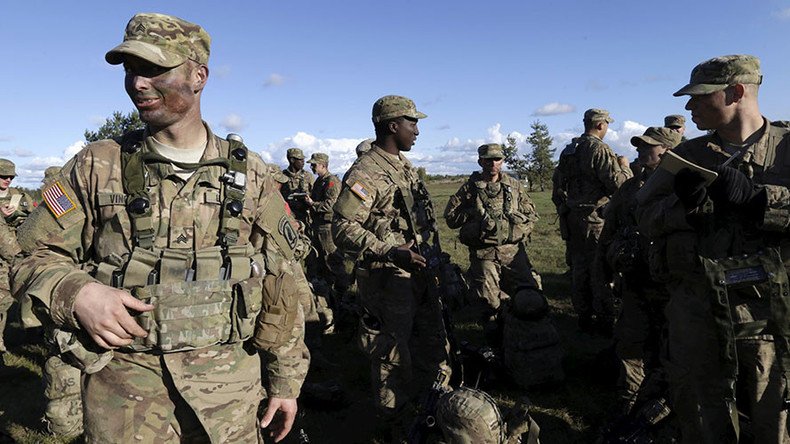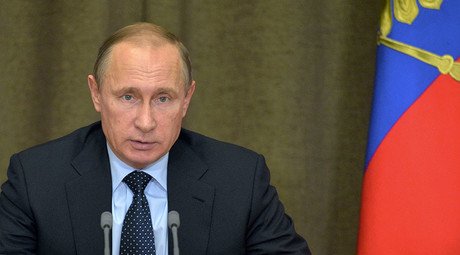American pundits prostituting on behalf of defense industry and (just maybe) World War III

US defense companies are currently enjoying a massive surge in profits in the wake of severe global crises that US foreign policy – with the full backing and blessing of the US punditry class - has itself precipitated.
It’s pretty much guaranteed that your breakfast will be ruined when the very first line you read in the morning newspaper is a bold-type, bald-faced lie that goes: “Ever since Russia invaded Ukraine in 2014 and seized control of Crimea, Pentagon planners have been trying to figure out how they could cope with further land grabs by Moscow.”
Thus began the latest anti-Russia stink bomb, this one courtesy of Loren Thomson, a contributor to Forbes.
Before I continue, I would like to suggest that every article on Russia that is mass produced by the US corporate fear factory be required to carry a warning label by the US Surgeon General that states: “Reading this article may cause serious side effects, including hypertension, high blood pressure, domestic violence, erectile dysfunction and an overwhelming urge to seek membership in the National Rifle Association. Please immediately consult a physician if you experience one of more of these symptoms.”
But since I was provided no such advanced warning, I dove headlong into the article, screaming all the way through it like a kid experiencing his first roller coaster ride at Disney World.
Is it really necessary to explain once again that Russia never “invaded Ukraine in 2014” any more than it “seized control of Crimea”? This bucket of noxious libel is being dumped on Russia for two big reasons: 1. to coerce the Baltic States and Eastern Europe to crack open their small purses and buy expensive US military hardware, and 2. give the vampire of NATO the required invitation to enter the Bohemian wing of the European mansion.
Thompson then invites the reader to imagine a highly implausible, nightmarish scenario that would essentially spark World War III: “Internal Pentagon estimates suggest Russia’s military could occupy the Baltic States in 2-3 days – well before NATO could organize a coherent response.”
How Thompson got his hands on those “internal Pentagon estimates” he does not say, but he also glaringly failed to mention that for all intent and purposes, NATO already occupies the Baltic States.
In October, the first batch of heavy US military vehicles - 40 pieces of military equipment, including four M1A2 Abrams tanks and ten Bradley armored vehicles – was delivered from Latvia by rail to Estonia for the US 3rd Infantry Division. Last month, NATO forces opened a massive military exercise (‘Arrcade Fusion 15’) across the Baltic States of Lithuania, Latvia and Estonia that went for two weeks and involved over 1,700 troops from 20 NATO countries plus Sweden.
And even before Russia decided to involve itself in Syria to fight against Islamic State, NATO was conducting large-scale naval maneuvers off the Baltic coast. Twenty warships from nine NATO member states - Belgium, Estonia, Germany, Latvia, Lithuania, the Netherlands, Norway, Poland and the UK – kicked off Baltic Fortress 2015 exercises off the Lithuanian Baltic Sea coast.
In light of this unprecedented amount of NATO activity in the Baltic States, just miles from the Russian border, to suggest, as Thompson does, that NATO would somehow be caught unawares by a “Russian land grab” is either willful ignorance or an overt attempt to make readers, not to mention Baltic leaders with their nervous hands on the purse, believe imperialistic Russia is on the verge of attacking these former Soviet republics.
“U.S. military forces are located far from where the military action might start, and would have great difficulty responding rapidly to a Russian invasion that began with no warning,” Thompson writes as if it is the 18th century and modern militaries have no access to omnipotent satellite systems or cruise missiles that can be launched at a moment’s notice from thousands of miles away – even if Russia would want to carry out such an expedition, which it certainly does not.
But Thompson’s trembling tirade doesn’t stop at the Baltic States: “More generally, the alliance’s entire eastern flank is vulnerable to invasion given the proximity of Russian forces and the absence of natural barriers to a quick advance.”
Thompson seems to be sleepwalking through a dream landscape where suddenly NATO is surrounded by Russian forces and he’s left pondering how that happened. It’s almost as if NATO brass were huddled around a table in Brussels one morning when they arrived at an astonishing conclusion: The number of Russians increases in direct proportion to how close NATO gets to the Russian border. Eureka, imagine that! As NATO continues its inexorable sprawl east, the number of Russian sightings increases exponentially because, to borrow the parlance of the late comedian Sam Kinison, YOU’VE TRAVELED SO FAR EAST YOU’VE ENTERED RUSSIA’S BACKYARD, AAAH-AAAH-AAAAAAAHHH!

Thompson somehow fails to wrap his brain around a very simple fact: If NATO continues to expand its membership – something it promised not to do following the collapse of the Soviet Union – then Moscow has no other choice but to believe that the 28-member military bloc exists as an existential threat to Russia (In addition to NATO expanding into Russia’s sphere of interest, Washington has refused Russia's participation in the US missile defense shield in Europe).
First time in Europe: US Navy successfully intercepts missiles during war games (VIDEO) https://t.co/PuE8e40UT2pic.twitter.com/ef87NP8FDQ
— RT (@RT_com) October 21, 2015But the contributor for Forbes, whose blog says he “writes about national security, especially its business dimensions,” fails to see the connection between the never-ending growth of NATO and the easily anticipated Russian reaction.
Russia “routinely conducts military exercises near the eastern borders of Estonia, Ukraine, and other nearby states it might invade.”
Or maybe nearby states Russia could be potentially invaded from?
In fact, Russia only really started paying serious attention to its western flank - and especially the exclave of Kaliningrad, sandwiched strategically between Poland and Lithuania - once it became apparent that its so-called NATO partners in general, and the United States in particular, wanted no real formal cooperation with Russia, despite empty pledges of a ‘reset’ and a joint front against terrorism.
In the final analysis, I can only imagine that it is a positive thing that “Western military planners no longer think they can predict how Russian leader Vladimir Putin might react to perceived provocations or opportunities,” as Thompson suggests.
Only in the event that the Western military bloc understands that there are some national leaders left in the world who have no desire to succumb to the chaos of a new world order imposed by one government can there be some real hope left for peace in the world.
Perhaps that is extreme wishful thinking, but it seems to be all we’ve got left. Unless, of course, you happen to be an American political pundit, then you've got lots of business with the defense industry.
The statements, views and opinions expressed in this column are solely those of the author and do not necessarily represent those of RT.














